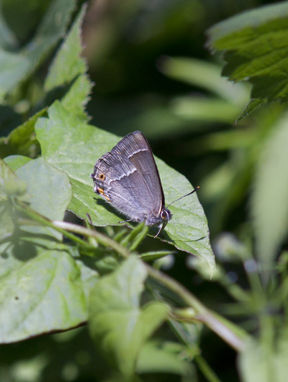Butterflies
Skippers
Whites
Hairstreaks
Blues and Coppers
Admirals
Vannesids
Fritillaries
Browns
Emergence
| Year | First |
|
| 1976 | 7 July WH | |
| 1977 | ||
| 1978 | ||
| 1979 | ||
| 1980 | ||
| 1981 | ||
| 1982 | ||
| 1983 | 23 July Ha | |
| 1984 | 21 July Ha | |
| 1985 | 15 Au Ha | |
| 1986 | ||
| 1987 | ||
| 1988 | ||
| 1989 | 7 Aug Sh | |
| 1990 | 12 Aug BR | |
| 1991 | ||
| 1992 | ||
| 1993 | ||
| 1994 | ||
| 1995 | ||
| 1996 | ||
| 1997 | 2 Aug BR | |
| 1998 | ||
| 1999 | ||
| 2000 | ||
| 2001 | ||
| 2002 | ||
| 2003 | 19 July BR | |
| 2004 | ||
| 2005 | 11 July BR | |
| 2006 | 11 July BR | |
| 2007 | 10 July BR | |
| 2008 | 5 July BR | |
| 2009 | 3 July BR | |
| 2010 | 19 July BR | |
| 2011 | 15 June BC | |
| 2012 | 26 July BR | |
| 2013 | 6 Aug BR | |
| 2014 | ||
| 2015 | ||
| 2016 | 13 May Hay | |
| 2017 | ||
| 2019 | NR | |
| 2020 | 15th JuneBC | |
Submit Your Records & Comments Here
Butterfly Survey 1976-2020
Purple Hairstreak

Wingspan - 39 mm
A remarkable statistic: my record of the purple hairstreak in 1976 was the only one that I recorded in ten years of consistent field work at Shoreham, White Hill, and it occurred on the very first day I spent there. No amount of searching revealed another and it was not until the 1980's that I discovered a colony in the oaks on the opposite side of the valley above Andrews and Pilots Wood. The butterfly is, in fact, VERY common in its chosen locality, such as Hayes Common, Keston, Coney Hall and The Rookery- Norman Park. These places are full of suitable host trees for the larvae - semi mature and mature oaks. The butterfly can be seen flitting around the canopy of these trees from early summer onwards. The butterfly is also present in North Bromley on old oaks near Foster Memorial Park.
Habit: male and female differ in size and by the amount of purple, blue iridescent scales present on the topwing which. The male has an overall purple effect, whereas the female's purple markings are concentrated into a smaller area of the topwing. The most frequent view will be of the butterflies silvery grey figured underwing, as it most often rests with its wings closed. The butterfly has a flitting movement and frequently comes to rest, (dropping down from the oak canopy to the lower level branches and occasionally to the ground, where animal and bird faeces form an a attractive source of important mineral nutrients.
Single brooded: over winters as an egg, which are laid close to buds - the larvae feeding up during the spring,
Larval Foodplant: Oak
Status: not under threat in our area - with numbers fluctuating year by year - 2011 being a bumper year. 2012 was a very poor year, on account of the record wet and cold spring. The drop in song bird density might favour its development.
© Rodney Compton - thanks also to Howard Walmsley
WH-WhiteHill SH-Shoreham BR-Bromley BC-Bromley Common, Ha-Hayes BN-BromleyNorth/GrovePark EY-Eynsford Orp- Orpington HE-HighElms Ke-Keston LB-LocksBottom Bec- Beckenham Park
